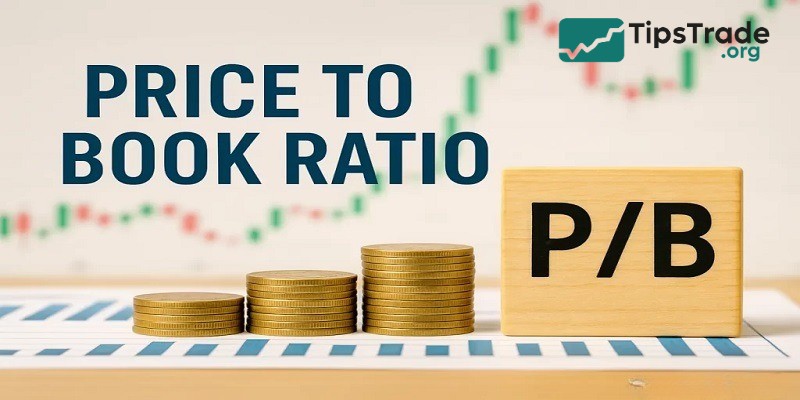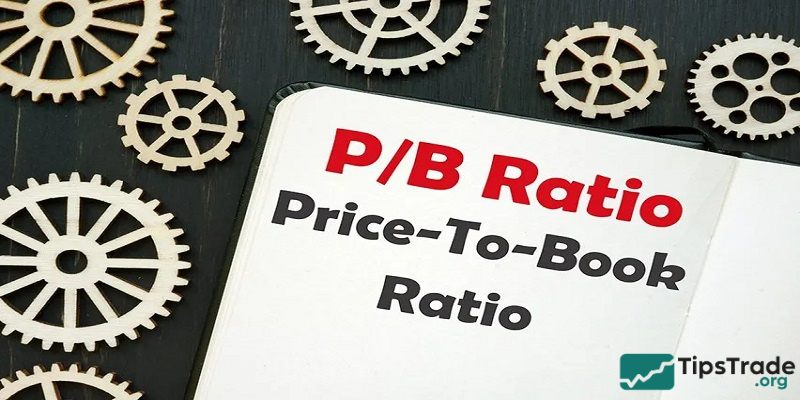The P/B ratio, also known as the Price-to-Book Value ratio, is an important financial metric used to compare a stock’s current market price with its book value. So, what is the P/B ratio? What P/B level is considered good? How does P/B differ from P/E? Check out the article below for more details!
What is the P/B ratio?
The P/B ratio, short for Price-to-Book ratio, is a financial metric that reflects the relationship between a stock’s current market price and its book value.
Simply put, the Price-to-Book ratio helps you determine how many times higher or lower a stock’s market price is compared to its book value. This allows you to identify quality stocks to invest in more effectively while minimizing the risk of losses.

>>See more:
- What is P/E ratio? Is a low or high P/E ratio better?
- Return on Equity (ROE) Calculation and What It Means
- Return on Assets (ROA) – What Is It, Formula and Calculation
- Debt-to-Equity (D/E) Ratio Formula and How to Interpret It
Why is the P/B ratio important
The Price-to-Book ratio can be used to evaluate a company’s stock price in comparison with the book value of the issuing business. A low Price-to-Book ratio may indicate that the company’s stock price is significantly lower than its book value, reflecting the market’s low expectations for that stock.
Meanwhile, a high Price-to-Book ratio relative to net assets may indicate that the company’s stock price is much higher than its book value, suggesting that the market values and expects strong performance from the stock. Investors are willing to pay a price higher than the company’s recorded book value in order to own that stock.

Specifically, in each case, the P/B ratio conveys different meanings:
- P/B > 1: The market price is higher than the stock’s book value. This implies that the market has strong expectations for the company’s performance and anticipates that the stock will grow in the future.
- P/B < 1: Two market tendencies may occur. First, investors may believe the company’s business outlook is unfavorable, leading them to pay only a low price for its shares. Alternatively, the company may be in the process of recovering after a crisis, with gradually improving business results, causing its book value to rise. In this scenario, the stock may be undervalued compared to its intrinsic value – creating an opportunity for investors to buy in and potentially earn future profits.
However, the Price-to-Book ratio is not a perfectly accurate ratio and should not be used in isolation to assess a company. It does not provide information about a company’s growth rate, profitability, or business model. Investors should combine it with other financial metrics to make the most appropriate buy or sell decisions.
P/B ratio formula
The formula to calculate the Price-to-Book ratio is simple:
Price-to-Book ratio = Market Price per Share / Book Value per Share
Where:
- Market Price per Share is the current trading price of a company’s stock.
- Book Value per Share is calculated as Shareholders’ Equity / Number of Outstanding Shares.
For example, Company XYZ has a book value per share of ₹100 and its current stock price is ₹200 per share. To calculate the price-to-book value for Company XYZ, we would divide the current stock price by the book value per share:
so, ₹200 / ₹100
=> Thus, the P/B ratio = 2.0
What is a good P/B ratio?
To determine whether the Price-to-Book ratio is high or low, you should compare it to 1, specifically:
– P/B > 1 (high): The stock is being valued higher than its book value. Investors have high expectations for the company’s growth potential and are willing to pay a premium to own the stock.
– P/B < 1 (low): The stock is being valued lower than its book value. This may come from one of two reasons:
- Investors perceive the company’s business performance as unattractive or lacking future prospects, causing the stock price to drop and the P/B ratio to fall below 1.
- If the company is actively recovering and growing after a downturn, the P/B ratio may still remain low, but this presents an opportunity to buy a good stock at a bargain price.

In reality, it is difficult to determine an ideal Price-to-Book ratio for selecting stocks in the market. You need to compare a stock’s P/B ratio with the industry average and its competitors to make the most accurate assessment.
Additionally, you should consider various related factors such as profitability, growth rate, competitive advantages, industry potential, economic conditions, market trends, and combine these with other financial ratios such as ROA, ROE, and P/E to select the best stocks.
The higher the Price-to-Book ratio, the greater the investment risk, and vice versa. If you do not have much experience, it is safer to choose stocks with a Price-to-Book ratio ranging from 0.7 to 1.5.
Advantages and disadvantages of P/B ratio
In reality, no financial metric is 100% perfect, so P/B also has its own advantages and limitations:
Advantages of P/B ratio
- P/B is always positive: For businesses with unstable profits or those operating at a loss, the Price-to-Book ratio can be zero or negative, making it meaningless. Meanwhile, the Price-to-Book ratio is always positive, allowing you to analyze the stock even when the company is losing money.
- High stability: A company’s book value (net assets) tends to fluctuate very little. Therefore, during short-term periods of strong market volatility, the Price-to-Book ratio provides a more stable and reliable view when assessing a stock’s long-term value.
- Good analytical effectiveness: The Price-to-Book ratio focuses on net asset value, making it suitable for companies with large tangible assets since the book value of these businesses is usually clear, easy to calculate, and less influenced by intangible assets.

Disadvantages of P/B ratio
- Does not account for intangible assets: The Price-to-Book ratio is calculated based on tangible assets such as factories and machinery, and it ignores all intangible assets like brand value, patents, etc. This can lead to undervaluation or misvaluation of companies with large intangible assets, especially in technology or consumer sectors.
- Does not reflect current value: The book value of assets is recorded at the time of purchase or investment. After several years, this value often changes very little or not at all, while the actual market value of the assets may have increased or decreased significantly. As a result, the Price-to-Book ratio does not accurately reflect the current value of the stock.
- Affected by accounting principles: Different accounting methods may record asset values differently, increasing or decreasing a stock’s book value compared to reality. This can make the P/B ratio “distorted,” causing investors to misjudge the stock’s true value.
- Not suitable for fast-growing companies: Companies, especially in the technology sector, often experience rapid growth, causing their market value to be much higher than their book value, leading to a high P/B ratio. However, this does not necessarily mean the stock is overvalued; it may simply reflect strong investor expectations.

The difference between P/B ratio and P/E ratio
The difference between P/E (Price-to-Earnings ratio) and P/B (Price-to-Book ratio): P/E compares a company’s stock price with its earnings per share, while P/B compares the stock price with its book value per share. Investors can refer to the key differences below:
|
P/E Ratio (Price-to-Earnings) |
P/B Ratio (Price-to-Book) |
|
|
Definition |
Compares a company’s stock price with its earnings per share. |
Compares a company’s stock price with its book value per share. |
|
Focus |
Reflects how much investors are willing to pay for each dollar of earnings. |
Indicates how many times investors are paying above the company’s book value. |
|
Purpose |
Used to assess the company’s future earnings growth potential. |
Used to evaluate the company’s market value relative to its net asset value. |
Conclusion
Hopefully, through the article above, you now have a better understanding of the P/B ratio. This is an important ratio that helps investors assess the value and development potential of a stock. However, to invest effectively, you should combine the P/B ratio with other financial metrics to gain a comprehensive view and make the most informed investment decisions.
See more:

